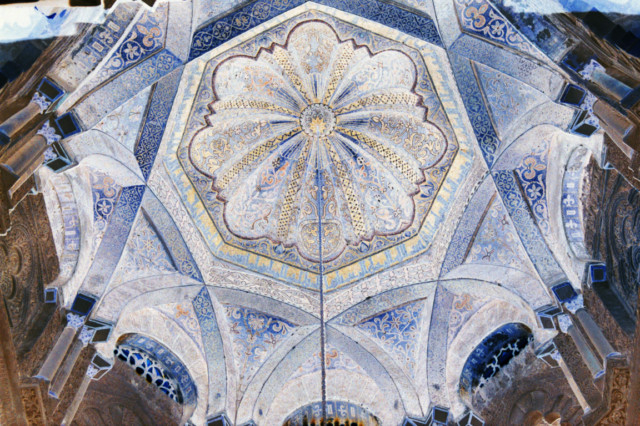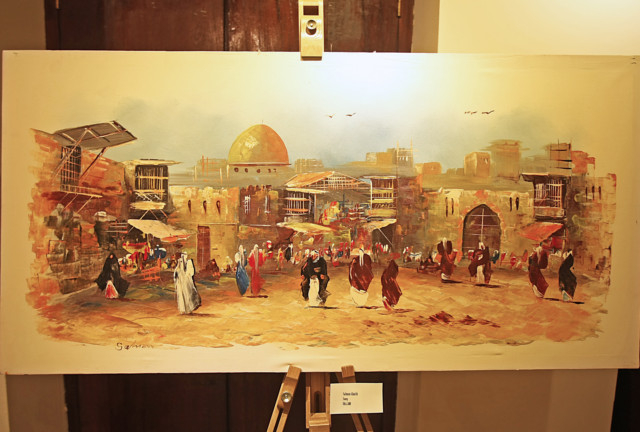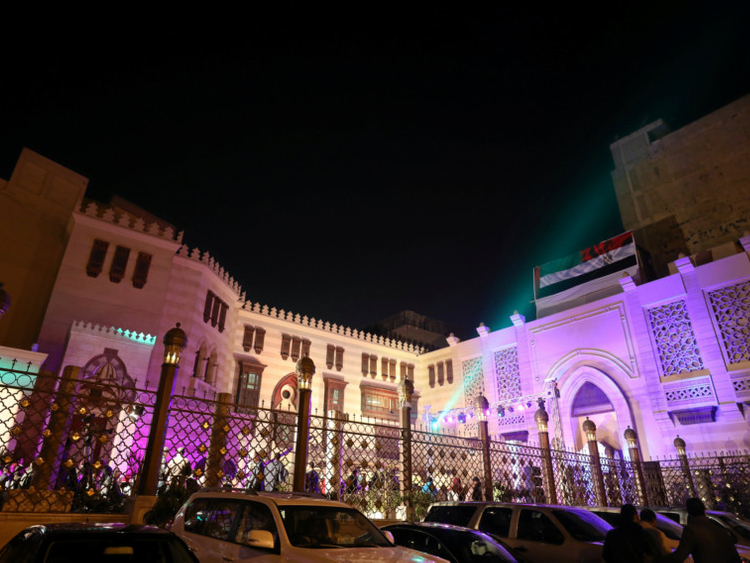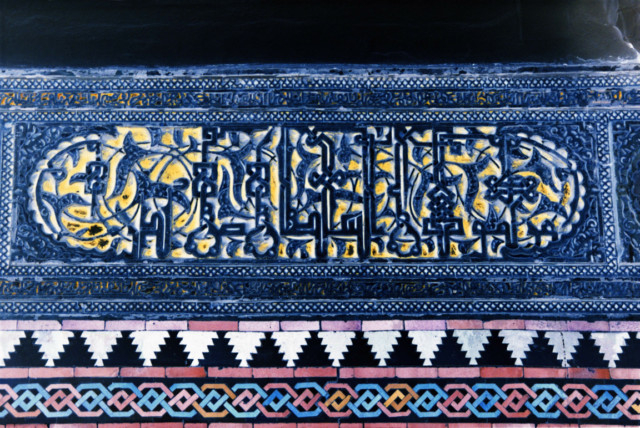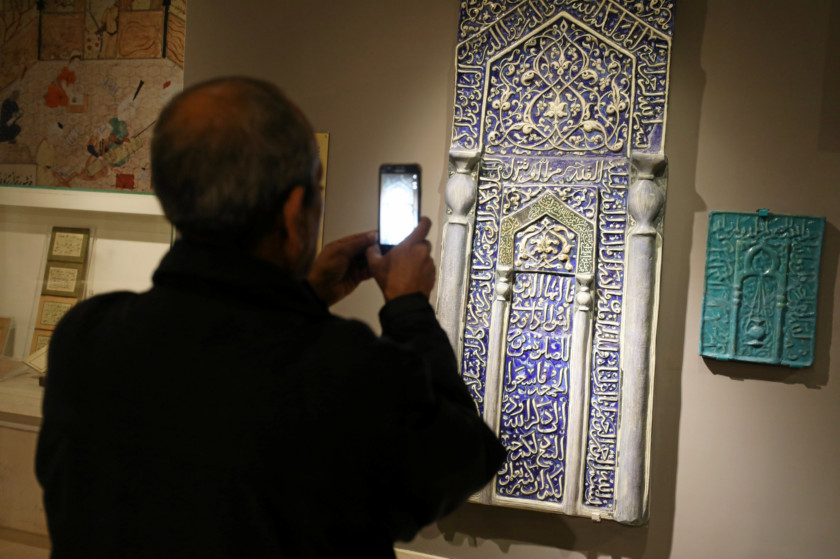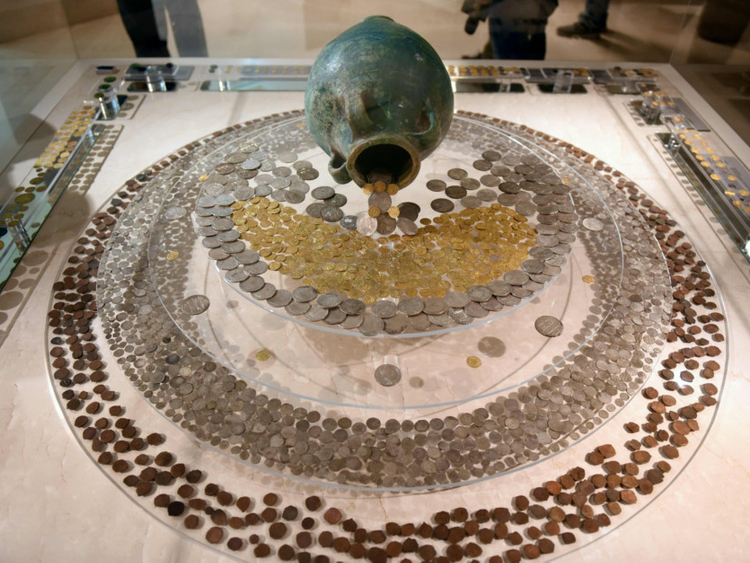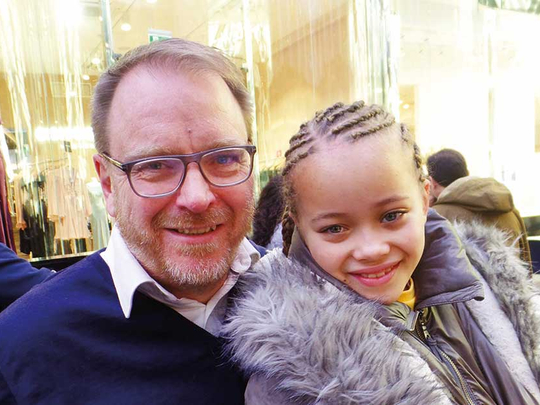
Eric Broug is a UK-based Dutch author and educator with an expertise in Islamic geometric design. “The wonderful thing about Islamic geometric design [is that] everybody recognises it,” he says.
“In fact Muslims and non-Muslims alike. It is such a recognisable aspect of Islamic visual culture. So you see it everywhere. If you go to a supermarket in the Middle East and you buy a packet of biscuits, there will be a little geometric pattern on there. Or you see a TV station logo or whatever. It is ubiquitous.”
I met Broug in a cafe in a mall in the Leeds town centre. His daughter, who accompanied him to the interview, remained quiet for the most part, engrossed in her own world.
Broug, who lives in nearby Halifax, travels fairly frequently to Dubai to conduct workshops and classes on Islamic geometric design.
READ MORE:
![]() Affordable Islamic art goes on show in Dubai
Affordable Islamic art goes on show in Dubai
Traditional Islamic art gets a modern touch
Cairo Musuem of Islamic Art reopens
“Dubai is the place I love visiting most of all,” he tells Weekend Review. “Partly just because there are things I want to do there, and there is all the encouragement and support for me to do the things I want to do there.”
Broug was born in Gouda in the Netherlands. As a child, he lived in Australia and Indonesia for a few years before eventually moving back to Holland.
Fascinating
He studied Middle East politics at university in Amsterdam. His main interest was freemasonry in the Middle East, especially in Iran.
“With the advent of modern society... modern politics, you would get these, for example, Iranian diplomats who would go to France, they would see these masonic lodges being powerful behind the scenes, and they thought in Iran it is very difficult to speak openly about politics, about modernisation, things like that.
"But a masonic lodge offered you the opportunity to do that. So some of these young Iranians, and also in Egypt, they set up these organisations,” he says.
He found that fascinating, but not fascinating enough.
“I wanted to find something that I can be passionate about. Something that I love. And something that will be a challenge for me, a life challenge but also an intellectual challenge. And I didn’t know what that was but I knew it wasn’t Middle Eastern politics.” So Broug dropped out and took a job in a bookshop.
Deconstructing patterns
One day, Broug came across a book on Islamic geometric design and became fascinated. “The book only showed you the results, not the process. [It] showed you the patterns, not how they were made.” For 10 years he tried to deconstruct the patterns in order to reconstruct them. During that time he did not know anyone in the Netherlands who did Islamic geometric design. Eventually he decided to study Islamic design at the Princes School of Traditional Arts in London. After spending one year there, he went to the School of African and Oriental Studies (SOAS) to do a Masters in the History of Islamic Art and Architecture.
After moving to the north of England, Broug started working for a British academic publisher who did online peer review journals. He worked for them for 10 years.
“I did Middle East, I did North Africa, for me it was great. Because it was a good job. I travel. When I visit customers in Cairo, I can also go and visit Mamluk Cairo, or if I visit customers in Marrakech, I can also go and visit some buildings.
"Well you do your business meetings, and if there is time left over, then I wrote my big book [on] Islamic geometric design. I wrote a lot of that book in hotel rooms in the Middle East because I would be travelling and in the evening, I would just write and make illustrations.”
Impressed
Among the places which has impressed Broug for its design is the Sultan Hassan Mosque in Cairo, Egypt.
“If you go up the steps to Sultan Hassan mosque, before you go left to go inside, there is a niche with a geometric pattern in there,” he says.
“And all geometric patterns, this is also how I teach in workshops and in my books, have two layers. A visible layer, obvious, and an invisible layer.
"The invisible layer is the grid that makes it easier to create," he said. "And the invisible layer, as the word says, is always invisible except at this composition in Sultan Hassan mosque where for some reason either by intent or accident they both are visible — so for us that is great.
"People are interested in this because you can see how you use the grid to achieve things that would be difficult to do without — so that I find fascinating.”
Islamic geometric desing
In the modern era, there has been a decline in the standard of Islamic geometric design.
“If you walk around Dubai or any other city in the Middle East or South East Asia, you see buildings that have Islamic geometric patterns applied. But if you look a thousand years of design history, these patterns were applied in a particular way consistently. And there was very high quality, there was best practice. That knowledge is not there anymore. As a consequence, the way these patterns are used in contemporary architecture is not so good. It really isn’t and it doesn’t have to be like that.”
In the past there were certain rules that were always applied to these geometric patterns.
“The miracle really is that it doesn’t really matter if you go to Afghanistan, Pakistan, India, Morocco, or Egypt, the way these patterns were used in architecture, and also in books, it was always done with certain rules that were always applied. Always. And you wondered how did they transfer this knowledge? But even without answering that question, the fact that it happened, that is the miracle and those rules that were applied, we should know what they are.”
He has noticed too much focus on only a few design patterns. “What I am also passionate about is that there is such an enormous repertoire to choose from if you wanted to apply these patterns in contemporary architecture and design. Rather than always choosing the usual suspects, One can choose this Ghurid pattern from Afghanistan, or why not choose this pattern from Thatta in Pakistan? Or whatever. It is always all there for the taking. I find it fascinating that how many different patterns there are but also how you can find these things made 900 years ago and stand there, look at them, analyse them and think somebody made this with just a compass and a ruler.”
Sadly these centuries-old rules of Islamic geometric design are being ignored today. “If you look at the pattern in a rectangular frame, you could follow a line with your finger all the way across. And it is just that the pattern is infinite. Sort of the philosophical aspect of Islamic geometric design. What you see a lot in contemporary patterns is that patterns undue that. They create deep intersections, a line would go like this. For a thousand years that has been a total no, no,” Broug says.
What are the reasons for this decline? “It is also an area which is relatively under-researched,” says Broug. “But if you think about how traditional arts and crafts were supported, you would have the system of apprentices. Boys 10, 11 or 12 would start working in the workshop. They would do this for many years and then they would move up. Economic pressures make that different. And you see that for example in Cairo. Cairo is one of the best places for Islamic architecture. I love to go there. You can’t walk for 10 metres without tripping over a masterpiece. But now, when you see what you can buy in Khan Al Khalili for the tourists, it is all these little boxes with geometric patterns, and it is okay. But it is nothing like it used to be done.”
Making a living
One of the factors which comes into play is economics. “It is just because the people who make these things need to make a living, and they need volume. They need to make lots of these boxes because they are cheap and they need to sell a lot of them.”
Another reason is the lack of education. “You can’t blame the architects and designers for that. If you have to blame anyone — educators and policymakers, because everybody does copy and paste.”
Broug’s efforts to promote Islamic design have attracted the attention of some influential people. There is a photograph on his website of Shaikh Hamdan Bin Mohammad Bin Rashid Al Maktoum, Crown Prince of Dubai, leafing through one of his books. “He was there at the Global Islamic Economy Summit. He saw my book, which is good enough for me. I would like to give him a copy once at some point. Insh’Allah it will happen. We will see.”
For Broug it has always been interesting to connect traditional with contemporary, and to link the past with the present and future. “A lot of people consider Islamic geometric design to be cool, and so do I,” he says. “I think, because it is such a uniquely positive aspect of Islamic culture. If you go to the Alhambra, for example, you see all these foreign tourists queuing up. Everybody goes there because they love to see Islamic geometric design.”
Broug feels Islamic geometric design chose him, rather than the other way around. Last year, as a birthday present to himself, he quit his job to focus on his work as a writer and teach Islamic geometric design.
“I want to make a difference. I am not going to do that living in Halifax, no matter how many times I travel. The idea is to set something up in Dubai, like a heritage centre for Islamic geometric design. That is the big dream. You know Dubai likes big dreams. So why not?”
Syed Hamad Ali is a writer based in London.



